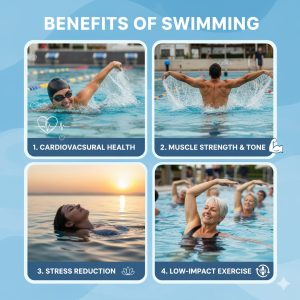BENEFITS OF SWIMMING

The Amazing Benefits of Swimming for Your Body and Mind
Swimming is one of the most effective full-body workouts you can do. It engages all major muscle groups at once, minimizes joint stress, and strengthens both your cardiovascular and respiratory systems. Thanks to the natural resistance of water, swimming offers a low-injury, high-efficiency workout suitable for all ages. Let’s explore the key physical and mental benefits of swimming.

1. Swimming for Heart and Cardiovascular Health
One of the greatest benefits of swimming is its positive effect on the heart. Regular swimming helps:
-
Strengthen heart muscles
-
Regulate blood pressure
-
Improve blood vessel elasticity
-
Lower bad cholesterol (LDL) and raise good cholesterol (HDL)
-
Enhance heart rate control
For individuals at risk of heart disease, low-intensity swimming can be a safe and effective way to support cardiovascular health.
2. A Full-Body Workout
Swimming doesn’t just provide cardio benefits — it works your entire body from head to toe. Every stroke activates multiple muscle groups simultaneously, including your arms, back, legs, abs, and glutes.
This full-body engagement helps:
-
Correct posture problems
-
Improve muscle tone and endurance
-
Increase strength and flexibility
So if you’ve ever wondered “Does swimming build muscle?” — the answer is absolutely yes. It’s one of the few sports that build both strength and flexibility together.
3. Swimming for Joint Pain Relief
The buoyancy of water makes swimming an excellent choice for people with joint problems or arthritis. Water’s natural lift:
-
Reduces pressure on joints
-
Increases mobility in conditions like osteoarthritis
-
Provides a safe rehabilitation method after injury
Because of this, swimming is often included in physical therapy and rehabilitation programs.
4. Improves Lung Capacity and Breathing Efficiency
Swimming requires rhythmic breathing, which strengthens respiratory muscles and improves lung capacity. This can be particularly beneficial for people with asthma or other respiratory conditions.
Regular swimming helps:
-
Increase oxygen efficiency
-
Enhance lung elasticity and volume
-
Support better oxygen balance in the bloodstream
5. Enhances Sleep Quality
One of the often-overlooked benefits of swimming is better sleep. Swimming relaxes both the body and the mind, helping you fall asleep faster and sleep more deeply.
After swimming, your body naturally increases melatonin and serotonin levels — hormones that regulate healthy sleep cycles and boost daytime energy.
6. Boosts Mental Health and Reduces Stress
Swimming is not just about physical fitness; it’s also a great mental therapy. Regular swimmers often report reduced stress and anxiety levels.
Swimming helps:
-
Decrease cortisol (stress hormone)
-
Trigger endorphin release for a better mood
-
Improve mental clarity and focus
-
Alleviate symptoms of mild depression
In short, swimming is both a workout and a form of moving meditation.
Different Swimming Styles and Their Benefits
Swimming comes in several styles, each targeting different muscle groups and offering unique health benefits. Whether you swim for fun, fitness, or therapy, all swimming techniques can improve your overall well-being.
Freestyle Swimming
The most popular and fastest swimming style. It combines rhythmic arm and leg movements, providing an excellent cardio workout.
Benefits of freestyle swimming:
-
Burns a high number of calories
-
Works all major muscles
-
Improves endurance and heart rate
-
Suitable for beginners and advanced swimmers alike
Backstroke Swimming
This technique is ideal for improving posture and spine health. Swimming on your back keeps your head above water, making breathing easier.
Backstroke benefits include:
-
Strengthens back and neck muscles
-
Supports posture correction
-
Beneficial for spinal conditions like scoliosis
-
Recommended in rehabilitation
Breaststroke Swimming
A slower but highly technical style that emphasizes coordination and control. Perfect for relaxation and gentle exercise.
Breaststroke benefits:
-
Strengthens hips and inner thighs
-
Promotes smooth muscle coordination
-
Enhances balance and flexibility
-
Ideal for older adults or low-impact workouts
Butterfly Stroke
The most challenging style, requiring strength, rhythm, and endurance.
Butterfly stroke benefits:
-
Works shoulders, arms, abs, and back intensively
-
Boosts stamina and athletic performance
-
Increases body control and coordination
Swimming for Special Conditions
Swimming is not only for athletes — it’s also highly beneficial for specific health situations such as pregnancy, child development, and weight control.
Swimming During Pregnancy
Swimming during pregnancy offers gentle, full-body exercise without stressing joints or the spine.
Benefits for pregnant women:
-
Strengthens muscles safely
-
Reduces swelling and varicose veins
-
Improves circulation and breathing
-
Relieves back pain and enhances sleep quality
Swimming two to three times a week can help maintain a healthy pregnancy and reduce discomfort.
Swimming for Children
For children, swimming promotes healthy physical growth and emotional development.
Key benefits of swimming for kids:
-
Supports muscle and bone development
-
Improves coordination and balance
-
Builds confidence and discipline
-
Enhances focus and social interaction
Moreover, early swimming lessons teach water safety and reduce drowning risks.
Swimming for Weight Loss
Swimming is a top choice for losing weight efficiently and safely. It burns a high number of calories while being gentle on joints.
Benefits of swimming for weight loss:
-
Burns about 500–700 calories per hour
-
Builds lean muscle mass
-
Speeds up metabolism
-
Improves cardiovascular endurance
When combined with a balanced diet, swimming is a sustainable and enjoyable way to lose weight and stay in shape.
Safety Tips Before You Start Swimming
To fully enjoy the benefits of swimming, preparation is key. Jumping straight into the pool without warming up or hydration can cause cramps or injuries.
Pre-Swim Warm-Up
Spend at least 5–10 minutes warming up before swimming. Stretch your shoulders, neck, and legs to improve flexibility and prevent muscle strain.
Other Important Tips:
-
Always swim in safe, supervised areas
-
Stay hydrated before and after your swim
-
Avoid swimming right after heavy meals
-
Choose a swimming style suited to your fitness level
Final Thoughts
Swimming is more than just a sport — it’s a lifelong wellness habit. From improving heart health and posture to boosting mental clarity and mood, swimming offers a complete mind-body transformation. No matter your age or fitness level, making swimming part of your weekly routine is one of the best investments you can make in your health.





